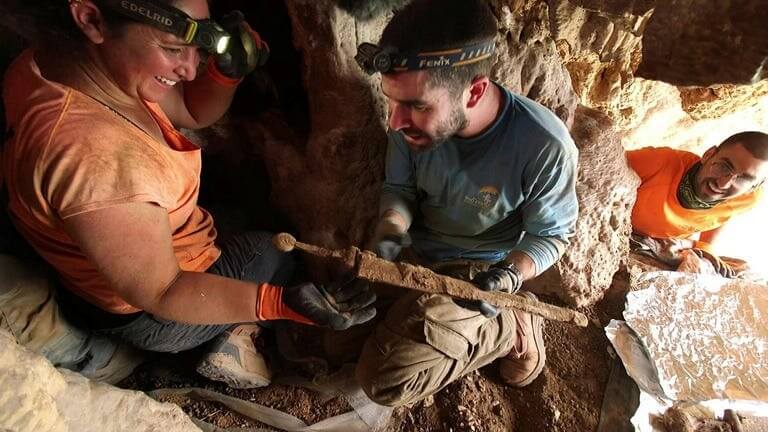Four 1,900-year-old Roman swords in near perfect condition found in cave near Dead Sea
The swords, three with their iron blades still in their scabbards, may have been hidden in this remote cliffside crevice by Jewish rebels during the Bar Kochba revolt

Graphic by Angelie Zaslavsky
This article originally appeared on Haaretz, and was reprinted here with permission. Sign up here to get Haaretz’s free Daily Brief newsletter delivered to your inbox.
Fifty years ago, a stalactite with an incomplete inscription in ink, written in ancient Hebrew characteristic of the First Temple period, was found in a small cave very high on the cliffs over the Dead Sea, north of the Ein Gedi oasis. Now in the present day, four extremely well-preserved Roman swords have been found in the same cave by researchers revisiting it to further study the inscription.
The cache of ancient weaponry had been shoved into a deep crevice about 1,900 years ago, the Israel Antiquities Authority announced on Wednesday. Such blades were standard issue to Roman soldiers and were most likely somehow obtained by the Judean rebels and hidden in the cave for later use, the researchers suggest.
The discovery was made by Dr. Asaf Gayer of the Department of the Land of Israel Studies and Archaeology at Ariel University, visiting the cave with geologist Boaz Langford of the Institute of Earth Sciences and the Cave Research Center at the Hebrew University of Jerusalem, as well as IAA photographer Shai Halevi.
“Finding a single sword is rare—so four? It’s a dream! We rubbed our eyes to believe it,” the researchers said in a statement. The swords, pilum in Latin, were exhibited for the first time Wednesday at an event celebrating the launch of the book “New Studies in the Archaeology of the Judean Desert: Collected Papers” describing archaeological finds unearthed in the Judean Desert Survey Project being conducted by the IAA.
The researchers’ were visiting the cave in order to photograph the inscription on the stalactite with multispectral technology in hopes of detecting additional parts of it no longer visible to the naked eye. While surveying the crevices in the cave, Gayer noticed the swords in a remote, quite inaccessible cleft in the cave’s upper level. Three still had their iron blades inside wooden scabbards.
Three were 60 to 65 centimeters long, a type classified as Roman spatha swords. The fourth was shorter, with a blade of 45 centimeters, which the researchers identify as a ring-pommel sword. Their handles were metal or wood. More wooden scabbard fragments were found in an adjacent niche, the IAA said.
The researchers reported the discovery to the IAA team surveying the Judean Desert caves in cooperation with the Ministry of Heritage and the Archaeological Office for the Military Administration of Judea and Samaria. Over six years hundreds of caves have been surveyed, resulting in 24 excavations, not least to frustrate would-be looters. In fact the swords were found in the course of meticulously surveying all the crevices in the cave, the IAA explains.
How did they get there? These were standard weapons of the Roman soldiers in Judea, and while these caves had a terrific view, they were not their usual stamping ground.
“The hiding of the swords and the pilum in deep cracks in the isolated cave north of Ein Gedi hints that the weapons were taken as booty from Roman soldiers or from the battlefield, and purposely hidden by the Judean rebels for reuse,” said Dr. Eitan Klein, one of the directors of the Judean Desert Survey Project in a statement.
“Obviously, the rebels did not want to be caught by the Roman authorities carrying these weapons. We are just beginning the research on the cave and the weapon cache discovered in it, aiming to try to find out who owned the swords, and where, when, and by whom they were manufactured,” Klein said. “We will try to pinpoint the historical event that led to the caching of these weapons in the cave and determine whether it was at the time of the Bar Kokhba Revolt in 132–135 C.E.”
Ancient metal is a rarity in archaeological circles. For one thing, in the age before electricity, metal was even more precious than it was today and old artifacts (or captured ones) would usually be melted down for reuse, or they would be ruined over time by corrosion caused by moisture.
The dry climatic conditions in the Judean desert preserved the weapons almost ideally, the researchers explain. The same applies to other remarkable discoveries made in the course of the desert survey, including an incredible large, woven basket from about 10,000 years ago, found in a cave called Muraba’at.
Following the swords’ discovery, the cave was excavated in its entirety by the IAA under the direction of Eitan Klein, Oriya Amichay, Hagay Hamer, and Amir Ganor. Other finds were dated to the Chalcolithic period about 6,000 years ago to the Roman period. And at the entrance to the cave, the team found a bronze coin from the time of the Bar-Kokhba Revolt. It can’t be stated that the coin reveals the stashers, but it is an intriguing thought.
During the survey, the IAA found evidence of looting in dozens of caves. “I shudder to think how much historical knowledge would have been lost had the looters reached the amazing artifacts in this cave first,” stated Ganor. “This time, thanks to the national project initiated by the Israel Antiquities Authority, we managed to get there before the looters.”













